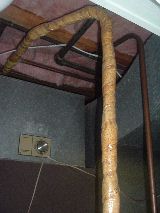
The first 6 feet of the hot water pipes (1.8 m), starting at the water tank, has been insulated with pipe wrap to prevent heat loss through convection.
|
| ... |
Pipe hangers
Copper pipes should be hung with copper or plastic pipe hangers. If another type of metallic hanger is used, localized rusting occurs where the metals make contact. Rusting also occurs at the connection of galvanized to copper pipes. |
|
.
|
| Hot and Cold Water Supply Pipes
|
|
| ....... |
Need more information? Use our search box
Water pipes. Galvanized pipes. Copper pipes. CPVC and Pex tubing. Water pressure.
Galvanized steel pipes were used until the mid 1950s and have an average life span of 40 years. Often the horizontal runs in the basement have been replaced with copper pipes while the vertical runs are still galvanized. In some cases only the hot water pipes have been replaced. Galvanized pipes rust from the inside out. Older pipes are often partially blocked by corrosion and the cause of low water pressure.
Copper, CTS, CPVC and PEX piping and tubing are some other options for hot and cold water distribution.
PEX tubing. PEX is one of the most versatile, easy-to-use plumbing systems on the market today, especially if it is used in conjunction with the Sharkbite Connection System.
Pipe hangers. Copper pipes should be hung with copper or plastic pipe hangers. If another type of metallic hanger is used, localized rusting occurs where the metals make contact. Rusting also occurs at the connection of galvanized to copper pipes.
Pipe spacing. Hot and cold water supply lines should be spaced 4-6" (100-150 mm). This is to prevent the cold water cooling the hot water pipes.
Insulate hot water pipes. Much of the heat loss occurs in the first 6 ft. (1.8 m) from the hot water tank.
|

PEX tubing
|
This section should be insulated to prevent heat loss through convection. However, the more you insulate (including pipes underneath countertops and vanities) the more you will save on energy.
Water pressure. Actual water flow is determined by the pressure of the city's water supply system, the size of the water main and supply lines, the condition of the faucets and the number of fixtures being used at the same time.
Water pressure can be improved by enlarging the supply lines (like the first 10 ft. from the water meter) or by replacing corrosion clogged galvanized pipes. If the water pressure is too high, it can be corrected by installing an adjustable pressure-reducing valve on the water main inside the house. |
|
|
|